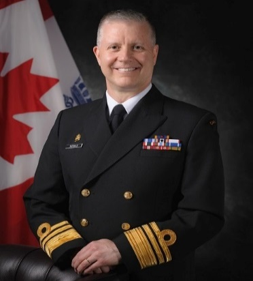March 2020 - Commander Royal Canadian Navy- Vice Admiral Art McDonald
Archived content
This page was proactively published to meet the requirements of the Access to Information Act. It is a historical record which was valid when published, but may now contain information which is out of date.
Biography
- Assumed command June 2019.
- Naval Warfare Officer, prior commands include: HMCS Halifax, Maritime Operations Group Five, Maritime Forces Pacific.
- Four tours in National Defence Headquarters as Deputy Commander RCN, Director General Naval Force Development, Director Naval Requirements, Executive Secretary to Commander of the RCN.

Mandate
- Prepare combat-effective naval forces that support Canadian interests at home and abroad.
- Protect Canadian sovereignty and economic interests.
- Work with the United States to protect continental maritime approaches.
- Support international security and rules-based international order by projecting force in the context of the North Atlantic Treaty Organization, United Nations, and multilateral missions.
- Provide Canadian presence on world’s oceans and engage Allies and partners through naval diplomacy
Key facts
Total Employees:
- 8500 Regular Force
- 3700 Reservists
- 4000 Civilians
Budget:
- $715,078,945 (FY19/20)
Primary location(s):
- National Defence Headquarters (Pearkes Building)
- National Capital Region
- Maritime Pacific Command (Esquimalt)
- Maritime Forces Atlantic (Halifax)
- 24 Naval Reserve Divisions across Canada
Key Partners
Internal:
- Canadian Joint Operations Command
- Strategic Joint Staff
- Canadian Army
- Royal Canadian Air Force
- ADM (Policy)
- ADM (Materiel)
- ADM (Human Resources) ADM (Science and Technology)
External:
- Global Affairs Canada
- Public Services and Procurement Canada
- Innovation, Science and Economic Development Canada
- Maritime Security Operations Centre
Partners & Allied Navies:
NATO and NORAD (Maritime Domain Awareness); Australia, New Zealand, United Kingdom, United States; [REDACTED].
Top issues for the Royal Canadian Navy
Current Fleet
- Halifax-class Frigates: Maintenance demand is growing as the ships age; requirement to sustain until arrival Canadian Surface Combatant (CSC).
- Victoria-class Submarines: Victoria-class Modernization (VCM) will modernize the RCN’s fleet of boats as they continue to operate into the mid 2030’s. Three key areas: Survivability; Habitability; and Operational Relevance.
- Kingston-class Maritime Coastal Defence Vessels: Intention to sustain vessels into the 2030s, will require additional National Procurement funding.
Future Fleet
The RCN is in midst of largest peacetime renewal in its history. Over the next two decades, a new ship will be introduced every two years. This effort will require significant effort to plan, coordinate, and sequence each ship’s release.
- Canadian Surface Combatant (CSC) Requirements Reconciliation is the first phase of the ship design process. The intention is to minimize change in order to begin deliveries in mid-2020s.
- Arctic and Offshore Patrol Vessels (AOPV) will deliver armed, sea-borne surveillance of Canadian waters, in the Arctic and offshore.
- This is the first ship of a new class being brought into service over the next 20 years. It will provide the RCN with a key opportunity to prepare for the delivery of follow-on ships (such as the JSS and CSC).
- Joint Support Ship (JSS) initial construction began in June 2018. JSS is on schedule to be delivered in 2023 and will provide underway support to Naval Task Groups, sealift capability, and support to operations ashore.
Infrastructure
- Naval infrastructure is deteriorating and starting to impact operations and quality of work-life for personnel.
- Current/forecasted funding will do little to curb downward trend.
- Additional resources and rationalization will be required.
- Revitalizing of RCN infrastructure required to support training of sailors for Fleet in Being and Future Fleet.
Personnel and Training
The RCN will:
- Maintain its focus on attracting and recruiting to RCN-managed occupations.
- Continue its organization design analysis to align organizational structure with RCN and CAF strategic intent.
- Develop progressive personnel policies that embrace and promote diversity, wellness and the well-being of the RCN team.
- Proactively analyse and structure RCN-managed occupations and training to meet evolving demands.
Page details
- Date modified:

